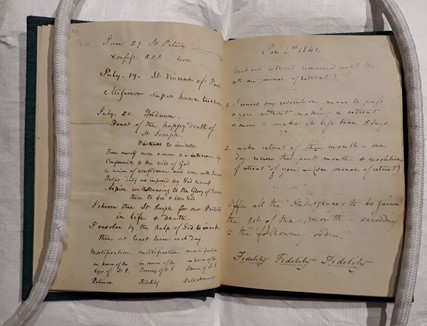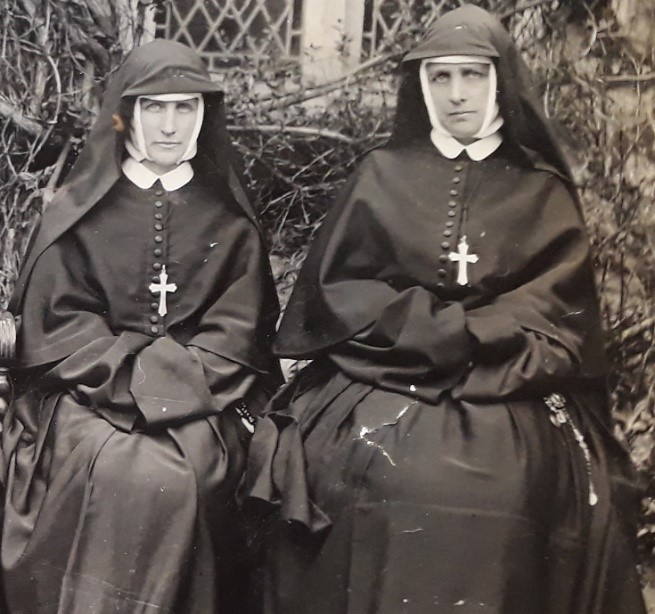‘Fidelity, Fidelity, Fidelity’: SHCJ Entering Religious Life
The 20th of January marked 100 years since the ceremony where Mother Mary Hildegarde Worsley became the first woman religious to be awarded the full Oxford degree.[1] The ceremony may have marked the end of the degree course she started after her profession, but it also signified the beginning of her work in SHCJ schools and ministries where all she had gained from her studies would be put to good use. As we begin a new year, this article describes how various SHCJ members entered religious life, overcoming their fears, and following their faith.
To celebrate the month of her birthday, this exploration of SHCJ vocations begins with an item kept by the Society’s Foundress herself, Cornelia Connelly’s spiritual notebook labelled ‘Interior life’. Cornelia begins in December 1839 with her resolutions, including ‘not to go one year without a retreat’. 180 years ago, Cornelia wrote an entry on New Year’s Day 1841 where she repeated this resolution. She also outlines that she will ‘Offer all the indulgences to be gained the 1st of the month in the following order. Fidelity – Fidelity – Fidelity’. [2]

An earlier page, where Cornelia recorded the tragic death of her two-year-old boy John Henry on 2nd February 1840, brings Cornelia’s constancy into sharp relief. This steadfastness to faith, despite bitter suffering and loss, was an attribute of Cornelia’s that allowed her to see through the Society’s establishment. Moreover, it is a quality that can be recognised in the women who became part of the SHCJ in the years to come.
The archives contain many memoirs written by members of the Society. Some volumes are an amalgamation of testimonies relating to one sister whereas others are autobiographical, such as Mother Mary Agnese Duckett’s ‘Reminiscences’. In one chapter, M.M. Agnese tells the tale of her vocation with a frank description of the conflicted feelings she experienced. When it was suggested she might come to St Leonards as a postulant at Christmas, M.M. Agnese recalls herself aged 19 exclaiming “No! I cannot miss all the balls and parties”. This was met with ‘a compassionate smile’ from Cornelia and the date was set at the Feast of the Purification, 1866.
Mary Jane soon found that her real trial would be to see the sadness of her parents at ‘the breaking of this first link of the united and happy family circle.’ She fell ill from exhaustion soon after receiving the hood and while lying in the infirmary overheard two nuns comment that she would ‘never have the health to go through our life’. Disconcerted by this, the young postulant was reassured the next day when Cornelia affirmed “you will get well, you will go through it”. With this encouragement the young woman recovered and went on to fulfil her vocation.[3]
One SHCJ who entered the noviciate in June 1901 remembers the grave anxiety caused by the prospect of taking vows. On the eve of her profession, the vows seemed to Sister Mary Amanda Molina D’Aranda ‘like a huge mountain I had to lift and could not’. Writing in 1972, Sister M. Amanda ‘never forgot’ the gentle words spoken by Mother Mary Etheldreda: “well dear, you are quite free and need not make them”. M.M. Etheldreda’s ‘patience touched me so much [...] that peace returned’. Sister M. Amanda faced her nerves with all her strength, but still found she had to pause part way through speaking her vows. The chaplain, a Benedictine named Father Almond, simply waited until she could finish. Later, to Sister Amanda’s relief, Father Almond admitted that he had the very same experience when making his vows.


Freda Walton (M.M. Theresa) and Mary Paley (M. St. Raphael) were both nicknamed Cornelia’s ‘ponies’ since they helped to push her bath chair around the grounds of St Leonards. The Foundress frequently remarked she could see both girls had ‘SHCJ written on their foreheads’. Freda’s route to see through her early vocation was complicated by a romance which bloomed when she was 18. After a party where the young man in question was suddenly seen by Freda ‘in a new light’, she broke off her engagement. Soon afterwards, her religious vocation was revived. Freda found, as Cornelia had assured her, that there was ‘always a home waiting for you here’ at St Leonards.
In one of the last plays Freda acted in while still a St Leonards pupil, she had the role of Cordelia in the 1872 Epiphany play. The famous lines from Cordelia to her father the King – ‘I return these duties back as is right and fit/ Obey you, love you and most honour you’ - were ‘felt and meant’ by Freda ‘as spoken to God’. At the end of her life spent as an SHCJ, M.M. Theresa told those around her that she had said these same lines of Cordelia ‘as a prayer all her life’.[5]
Thanks to the work of Sister Christine Carter and the former lay sisters of the SHCJ she interviewed, we have a valuable record of what led them to their vocation as well as the hardships and inequality they had to bear. ‘Impressed’ by the SHCJ nuns and their way of life when she worked as a Children’s Nurse in the Holy Child School in Birmingham, Sister Gemma (Johanna) Lucey knew ‘within myself’ that she was called to join the SHCJ. She also reflects in her interview on the fact that her skills as a nurse, who had qualified with distinction, were not properly utilised. However, she knew that she had been called and was ‘drawn by the Holy Child Spirit’.[6] ‘Despite ups and downs’ Sister Prisca (Ivy Gwendaline) Clench never thought of leaving the society, ‘I made my vows to live and die in the Society and that was a very serious undertaking’.[7]
Sister Isobel (Mary Harriet Hannah) Winder recalled painful memories of ‘disillusionment’ when after her hooding ceremony the separation of choir and lay sisters became clear. Nonetheless, she felt ‘privileged and blessed’ both by her parents and in her religious life. Sister Isobel concludes with an observation perhaps familiar to all those who have known the struggle of living out their vocation, not least Cornelia herself, that ‘religious life is real, not an escape’.[8]
[1] Helen Forshaw, ‘Significant Events 1911-1940’, SHCJ History, Is. III, 1998, p.11.
[2] Society of the Holy Child Jesus European Province (SHCJ EP) Archives, G/100/25/1, 1839- 1844 Grand Coteau notebook, p. 15.
[3] SHCJ EP Archives, EP/400/2/DUCKETT Mary Jane/1, Reminiscences, pp 154 - 162.
[4] SHCJ EP Archives, G/100/26/4, Journal 1867 – 1876.
[5] SHCJ EP Archives, EP/400/2/WALTON Winifred/1, ‘Mother Mary Theresa (Winifred Walton) SHCJ 1857 – 1932’ Biography by Anon. pp. 9-18.
[6] Sister Gemma (Johanna Lucey) interviewed by Christine Carter Journey in Faith: Life Stories of Fifteen Holy Child Sisters in the European Province, pp. 28 -30.
[7] Sister Dismas (Isabella Flicker) interviewed by Christine Carter, Journey in Faith, pp. 20-22.
[8] Sister Isobel (Mary Harriet Hannah Winder) interviewed by Christine Carter, Journey in Faith, pp. 42–44.




